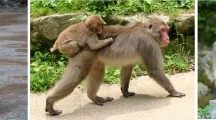Abstract
We investigated longterm socio-spatial relationships between adult males and immatures in a colony of Japanese macaques (Macaca fuscata fuscata), housed in a 1200 m2 indoor-outdoor enclosure at Cavriglia Natural Park (Arezzo, Italy). Using focal animal observations together with scan sampling, we found that the immatures between six months and one year of age showed particularly high frequency of proximity and vicinity to the male troop leader. The immatures-actively sought proximity to this individual, even if social interaction with him was minimal compared to other males with which high frequency of play occurred. Proximity to the leader (even) caused some mild aggressive response by him, showing that this individual tolerated, rather than sought, proximity to the immatures. Their behaviour was not mediated by the mothers, who might be expected to profit from their offsprings’ proximity to the leader. The leader seemed to support the immatures during aggressive interactions with a significantly high frequency due to their spatial proximity to him. This behaviour decreased during the following year. We interpreted the immatures’ behaviour as a social strategy expressed during an early phase of individual ontogeny to manipulate the leader’s “control” role and to explore the physical and social environment from a relatively secure position.
Similar content being viewed by others
References
Altmann, J., 1974. Observational study of behaviour: sampling methods.Behaviour 49: 227–265.
— 1980. Baboon mother and infants. Harvard univ. Press, Cambridge.
Berard, D.J., P. Nurnberg, J.T. Epplen, & J. Schmidtke, 1993. Male rank, reproductive behavior, and reproductive sucess in free-ranging rhesus macaques.Primates 34(4): 481–489.
Bernstein, I.S. & L. Sharpe, 1966. Social roles in rhesus monkey group.Behaviour 26(1–2): 91–104.
Busse, C. & W. Hamilton, 1981. Infant carrying by male chacma baboons.Science 212: 1281–82.
Camperio Ciani, A., 1984. A case of infanticide in a free ranging group of in the Jackoo forest, Simla, India.Primates 25(3): 372–377.
—, 1986. Le relazioni socio-spaziali fra maschi e piccoli in una colonia di in semicattivita’. In Genetica, evoluzione e comportamento del genereMacaca. Ph.D. thesis, Ministry of Pubblic Instruction, Rome.
Camperio Ciani A., C. Corradino, A. Lunardini & E. Righi, 1985. A general description of the ecology and organization of the colony established in the Cavriglia Natural Park (Arezzo), Italy.Antropologia Contemporanea 7(3):233–238.
Curie-Cohen, M., D. Yoshihara, L. Luttrell, K Benforado, J. Macluer & W.H. Stone, 1983. The effect of dominance on mating behaviour and paternity in a captive troop of rhesus monkeys (Macaca mulatta).American Journal of Primatology 3: 127–138.
Deag, J.M. & J.H. Crook, 1971. Social behaviour and “agonistic buffering” in the wild barbary macaque(Macaca sylvanus) Folia Primatologica 15: 183–200.
De Ruiter, J.R. & J.A.R.A.M. Van Hoff, 1993. Male dominance and reproductive success in primate groups.Primates 34(4): 513–523.
Dewsbury, D.A., 1982. Dominance rank, copulatory behaviour, and differential reproduction.Quarterly Review of Biology 57: 135–159.
Dolhinow, P. & N. Bishop, 1970. The development of motor skills and social relationships among primates through play. In Minnesota Symposia on Child Psychology. J.P. Hill (ed.), Univ. of Minnesota press, pp. 141–201.
Eaton, G.G., 1974. Male dominance and aggression in Japanese macaque reproduction. In: Reproductive Behaviour. W. Poirer W.H. Callir (eds.). Plenum press, New Yor, pp. 287–297.
Fedigan, L.M. 1982. Primate Paradigms. Sex roles and social bonds. Eden press, Montreal.
— & H. Gouzoules, 1978. The consort relationship in a troop of Japanese monkeys. In: Recent advances in primatology. Vol. 1. D.J. Chivers and J. Herberts (eds.) Academic press, London, pp. 493–495.
Gouzoules, H., 1984. Social relations of male and infants in a troop of Japanese monkeys: a consideration of causal mechanisms. In D.M. Taub ed. primate Paternalism. Van Nostrand Reinhold Inc, new York. Pp 127–146.
Hamilton, W.J., 1984. The significance of paternal investment by primates to the evolution of male-female associations. in Primate Paternalism. D.M. Taub (ed.) Van Nostrand Reinhold, New york, pp. 122–130.
Inoue, M., F. Mitsunaga, M. Nozaki, H. Ohsawa, A. Takenaka, Y. Sugiyama, Y. Shimizu & O. Takenaka, 1993. male dominance rank and reproductive success in an enclosed group of Japanese macaques: with special reference to post conception mating.Primates 34(4):503–511.
Itani, J., 1959. Paternal care in the wild Japanese monkeys (Macaca Fuscata).Primates 2:61–93.
Kummer, H., 1968. Social organization of hamadryas baboon. Univ. of Chicago press, Chicago.
Paul, A., J. Kuester, A. Timme & J. Arnemann, 1993. The association between rank, mating effort, and reproductive success in male barbary macaques (Macaca sylvanus).Primates 34(4): 491–502.
Smuts, B.B., 1985. Sex and frienship in baboons. Aldine, Hawthorne, NY.
— & D.J. Gubernick, 1992. Male infant relationships in nonhuman primates: paternal investment or mating effort? In: Father-child relations. B.S. Hewlett (ed.), Aldine De Gruyter, New York, pp. 1–31
Smith D.G., 1993. A 15-year study of the association between dominance rank and reproductive success of male rhesus macaques.Primates 34(4):471–480.
Stein, D.M., 1984. The ontogeny of infant adult male relationships during the first year of life for yellow baboons (Papio cynocephalus). In: Primate Paternalism, D.M. Taub (ed.), Van Nostrand Reinhold, New York, pp 37–48.
Strum, S.C., 1984. Why males use infants. In Primate Paternalism. D.M. Taub (ed.), Van Nostrand Reinehold, New York, pp. 146–185.
Van Noordwijk, C., 1985. The socioecology of long tailed macaque (Macaca fascicularis): 2) The behaviour of individuals. Ph.D. Thesis, Uthrecht, The Netherlands.
Vessey, S.H. & D.B. Meikle, 1984. Free living rhesus monkeys: Adult male interactions with infants and juveniles. In: Primate paternalism D.M. Taub (ed.), Van Nostrand, New york, pp. 113–125.
Witten, P.L., 1987. Infants and adult males. In Primate Societies B.B. Smuts, D.L. Ceney, R.M. Seyfarth, R.W. Wrangham, & T.T. Strusaker (eds.). Univ. of Chicago Press, Chicago, pp. 343–357.
Author information
Authors and Affiliations
Rights and permissions
About this article
Cite this article
Ciani, A.C. The strategies of immature Macaques in their interactions with adult males in a colony ofMacaca fuscata . Hum. Evol. 12, 139–146 (1997). https://doi.org/10.1007/BF02438064
Issue Date:
DOI: https://doi.org/10.1007/BF02438064




